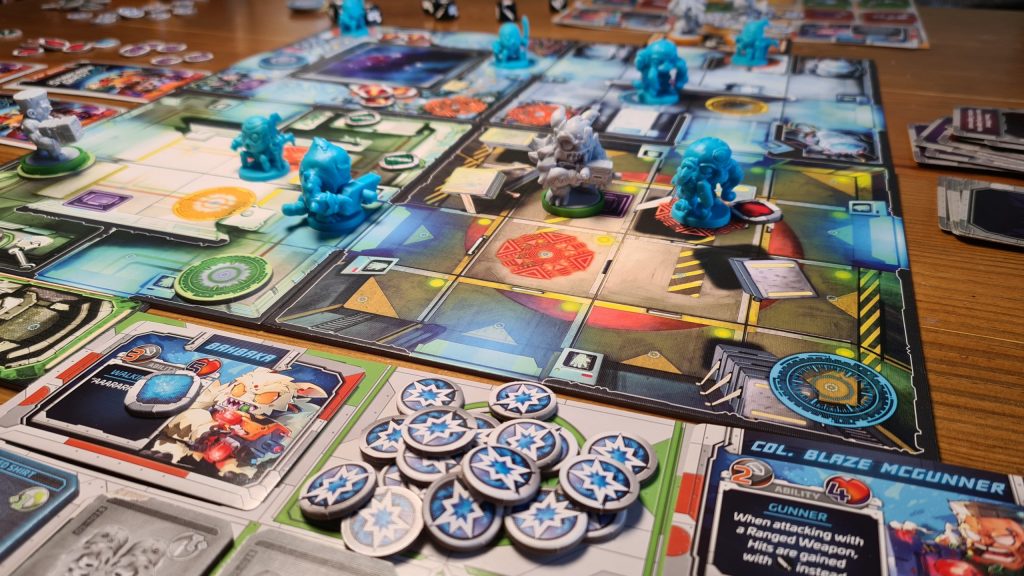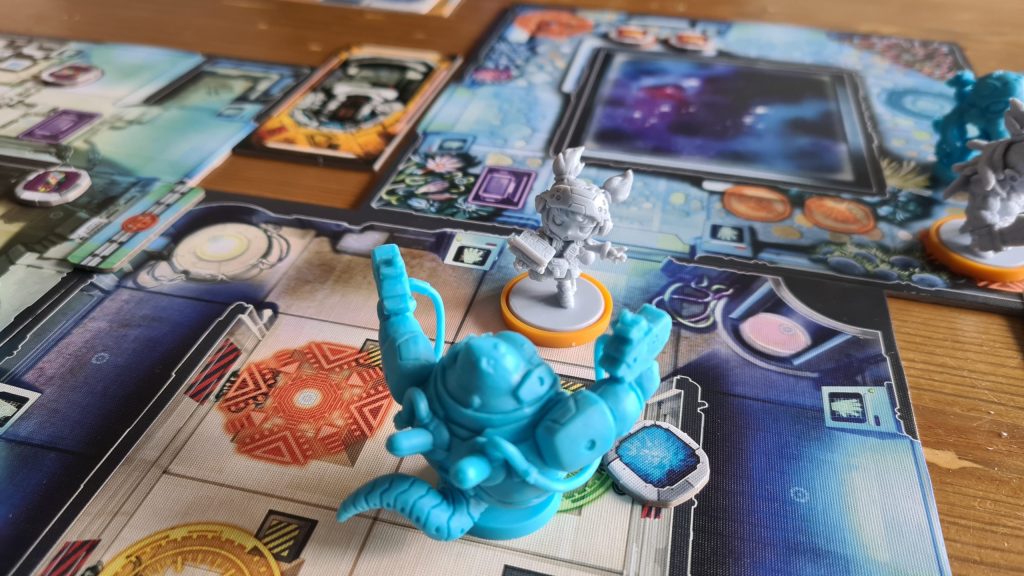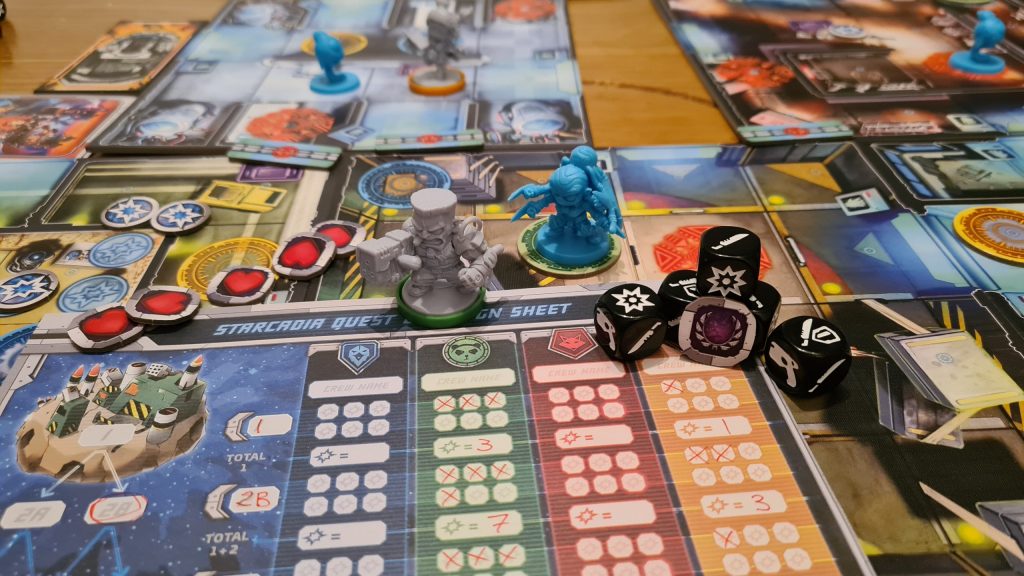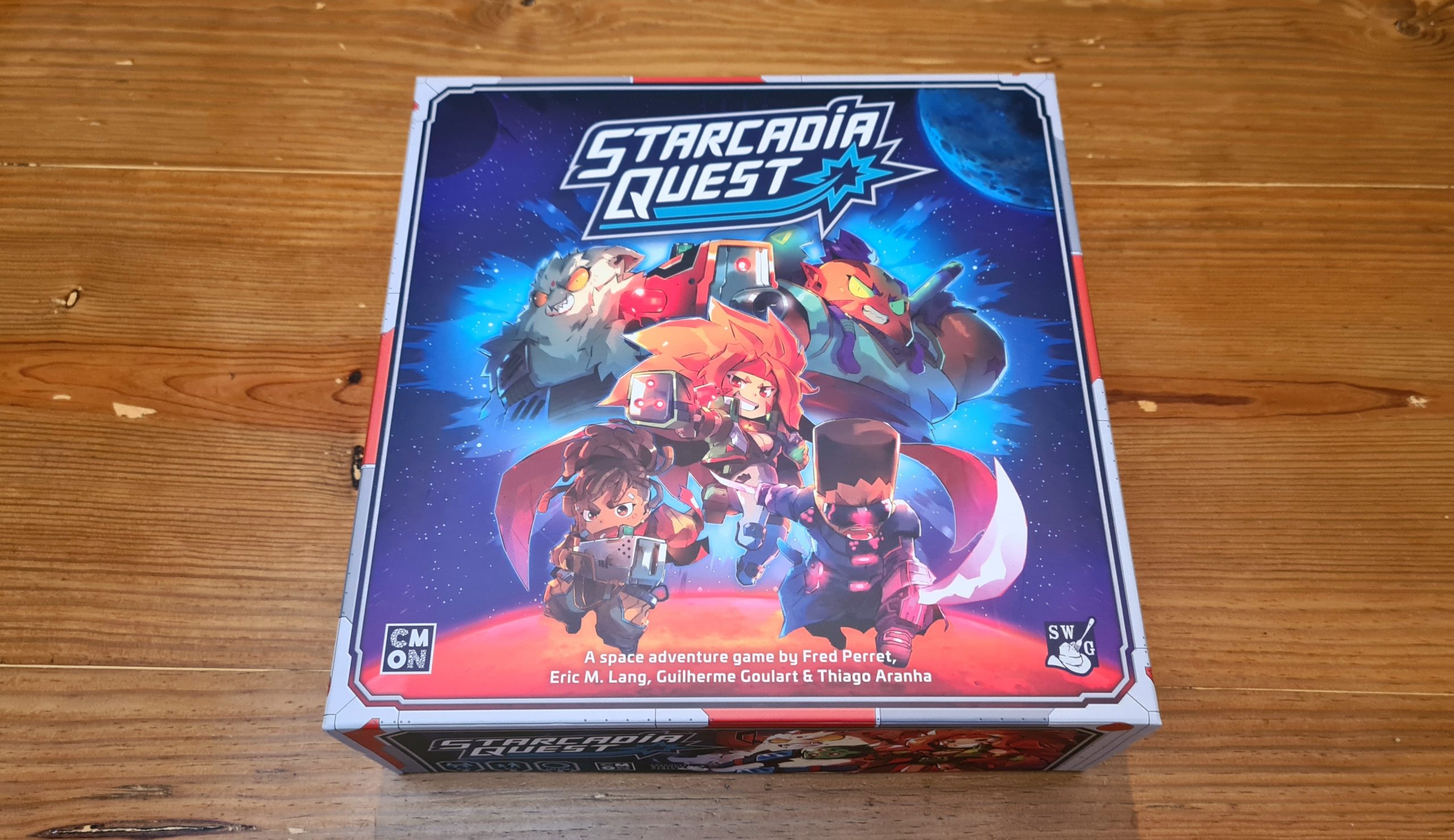Starcadia Quest is a sci-fi themed standalone miniature based campaign game, featuring a modular board, dice rolling and variable player powers. Published by CMON and designed by a team including Thiago Aranha and Eric M. Lang, the game sees 2 – 4 players each leading a crew of heroes. Completing quests, killing monsters and each other all helps crews score victory points, but the Supreme Commander Thorne must be defeated! However, will this reimplementation of Arcadia Quest be a successful one or a miniature too many? Let’s find out!
Setup from one scenario to the next, or even replaying the same one, is always a bit different. The map tiles are chosen at random, with the 10 map tiles shuffled and the number for the quest laid out in the denoted layout. The monsters that are in play can also be randomised, with quests only requiring 1 or 2 specific troopers and officers, with other slots on the monster board filled by shuffling the cards – based on their level. With this randomised setup scenarios then often have a few aspects that don’t change, at least too much. Commonly, some of the monsters spawn before the game begins and quest tokens are placed – with the exact locations based on features of the randomised tiles.
Players will be controlling a two person crew, with the heroes either randomly chosen or drafted. Each has their own unique ability, health and defence stats – though everyone gets an identical set of starting gear and a player board. Each hero can hold up to 6 upgrade tokens, including weapons, weapon boosts, passive armour and reaction items. Players choose how they would like to distribute the starting gear between their two heroes, though this isn’t set in stone for the entirety of the game.
On a turn the active player chooses to either activate a hero or rest. An activated hero can then, in either order, perform movement and attack. Often players will want to move about the map, with 4 action points available. These can be spent to move from one space to another, travel from one portal to another of matching colour and also to open or close doors. Either before or after movement the activated hero can attack monsters or heroes from other crews. Based on the upgrades the hero has they may be able to attack using a melee attack or a ranged attack. Both styles of attack see the player exhaust a weapon and any boosts they wish to attach.

The number of dice rolled is based on the exhausted tiles when attacking. Depending on the attack type players are either hoping for sword or gun symbols. CRIT symbols are successes regardless of what is being rolled for. Called exploding dice, when a player rolls a CRIT they also get to roll an extra dice, allowing for impossible odds to never be fully out of reach. Upgrades can also help with re-rolling dice, mitigating some of the luck from the game. Regardless of the target, the monster or hero will get a chance to defend – with monsters fighting back unless overkilled (when a specific number of hits or above are landed). Defending works in pretty much the same way, with dice rolled and shields and CRIT symbols counting as successes – which reduce the number of hits taken.
The second option for a turn is to rest. Being the lesser taken action, the active player’s turn is spent flipping over all of their exhausted upgrade tokens and respawning any of their killed heroes. At this point the active player can also redistribute their upgrade tokens between their crew. After both moving and attacking or resting the player must flip the top card of the event deck. These have two parts to them: a monster activation symbol and the actual event. Unlike other games the monster activation is fully determined by the active player. This means if a Scuttlebutt or Iceheart is activated by the card active player can move the monster and get it to attack a hero from a different crew! The events that trigger range from asteroids bumping everything in a room in one direction to seeing new portals be placed. These keep players on their toes, without ever being too impactful.
Play then continues to the next player, with them becoming the active player. Starcadia Quest isn’t just about killing monsters and heroes. Each scenario has a number of quests to be completed. A scenario ends when all PvE (player vs environment) objectives and at least one PvP (player vs player) objective have been completed. Like killing monsters and heroes these objectives are another way to earn victory points. The quests are dependent on the scenario, often only rewarding one crew. When enough objectives are complete the game ends and whoever has the most victory points wins.
Starcadia Quest doesn’t end there. While scenarios can be played individually they are meant to be played as a 4 game campaign. The campaign structure sees scenario 1 always being the same, with it then branching out into a choice by the winner of 2A or 2B. This then further fans out into 3A-C, before scenario 4 pulls everything back together. Even the start of scenario 4 depends on what scenario was previously played.

Giving the winner of a scenario this choice feels like a well earnt reward, though there are also upgrade tokens to be drafted – with the winner of a scenario getting first pick. Therefore, while in scenario 1 the crews only differ based upon hero powers, going into scenario 2 and beyond players will also have different gear. Importantly, the upgrades players start with aren’t automatically redundant. Even after the 3rd scenario players can still have a couple of starter upgrades kept instead of tokens gained after scenarios!
On average each scenario takes around an hour. However, the initial play will take a good chunk of extra time to get the game to the table. The rulebook is over 30 pages long and there are a couple hundred tokens to punch. After this though it’s only a few minutes to get the game to the table and going. This is due to the way the scenario setup cards neatly lay things out and the ease of explaining the general rules. As players aren’t overwhelmed with choices, either activate a hero or rest, they can quickly get playing.
The only surprise is that there isn’t a single shot scenario or tutorial. For many they won’t want to jump straight into a 4 game long campaign, despite being able to save your progress via a campaign sheet. Still, only briefly mentioned in the rulebook is to play a scenario as a standalone game. Having a specific one shot scenario would have been that further step towards lowering the already quite low barrier of entry. Starcadia Quest is on the simpler side of this style of game though. For example, as all of the environments are relatively small, ranged attacks are relatively streamlined. There is no weapon range to consider just line of sight – which is one less thing for new players to remember.
Starcadia Quest is marketed as a game for 2 – 4 players. An issue arises at 2 players due to the way that the winner of a scenario goes first in the next, gets the first pick of upgrades and naturally has earnt the most points in a round. With two players the scenario loser is now behind in the campaign and it can feel hard to comeback, despite being only a few dice rolls away. As soon as an additional player joins the mix there can be some self balancing, with the two players that didn’t win able to gang up on the leader. A dynamic of who has a target on their back then starts, with no-one wanting other players to get too far ahead. This ends up causing more PvP combat and the fun of the experience increases.

When unboxing one of the first things I noticed was that the map tiles weren’t double sided. Thankfully, Starcadia Quest gains variety by not specifying specific tiles. In CMON’s Zombicide missions require specific tiles in denoted rotations and which side of the tile to use. In Starcadia Quest a random selection of the 10 included map tiles are used – with no predetermined way specific tiles need to be laid out. This means two games can use the same 4 tiles for the same scenario (therefore the same layout) but still create a different map! Doubling down on this variety, the majority of the scenarios don’t see the map tiles aligned into a square or rectangle. The more sprawling shapes of the layouts mean the maps feel different from one shape to the next, even with the grid system.
Somewhat splitting opinion is the chibi style miniatures. Chibi is a cartoon like style where often, and is the case in Starcadia Quest, the head is much larger in proportion to the rest of the body. It allows the miniatures to have more details in the faces of the heroes and monsters, though the disproportionate sizing doesn’t sit right with everyone. They are all chunky plastic miniatures though, meaning that they are fairly resilient minis. So, there’s no worry if a load of dice bounce across the table into them. The high quality extends to the thick cardboard map tiles, and the many cards and tokens.
Starcadia Quest is the sort of game that looks daunting but is extremely easy to get to the table time and time again. The components, as with most CMON titles, create a visually stunning game that has plenty of table presence. The sign of a game hooking you in is when you instantly want more, in terms of playing more and wanting expansions. For example, take the troopers. 4 types are included, each with their own abilities, offering a good amount of variety straight out of the box. Still, it’s hard knowing more are available from expansions to not want them too! Starcadia Quest is a game that truly gets going when 3 players get around the table, with a touch more chaos and the ability to go after the leader. For this reason it is hard to recommend for 2 players. Regardless, it is thoroughly entertaining for 3 – 4, with two games never feeling the same!
(Editor’s Note: Starcadia Quest was provided to us by Asmodee for the review. The game is currently available from local board game stores! Find your local store here.)

